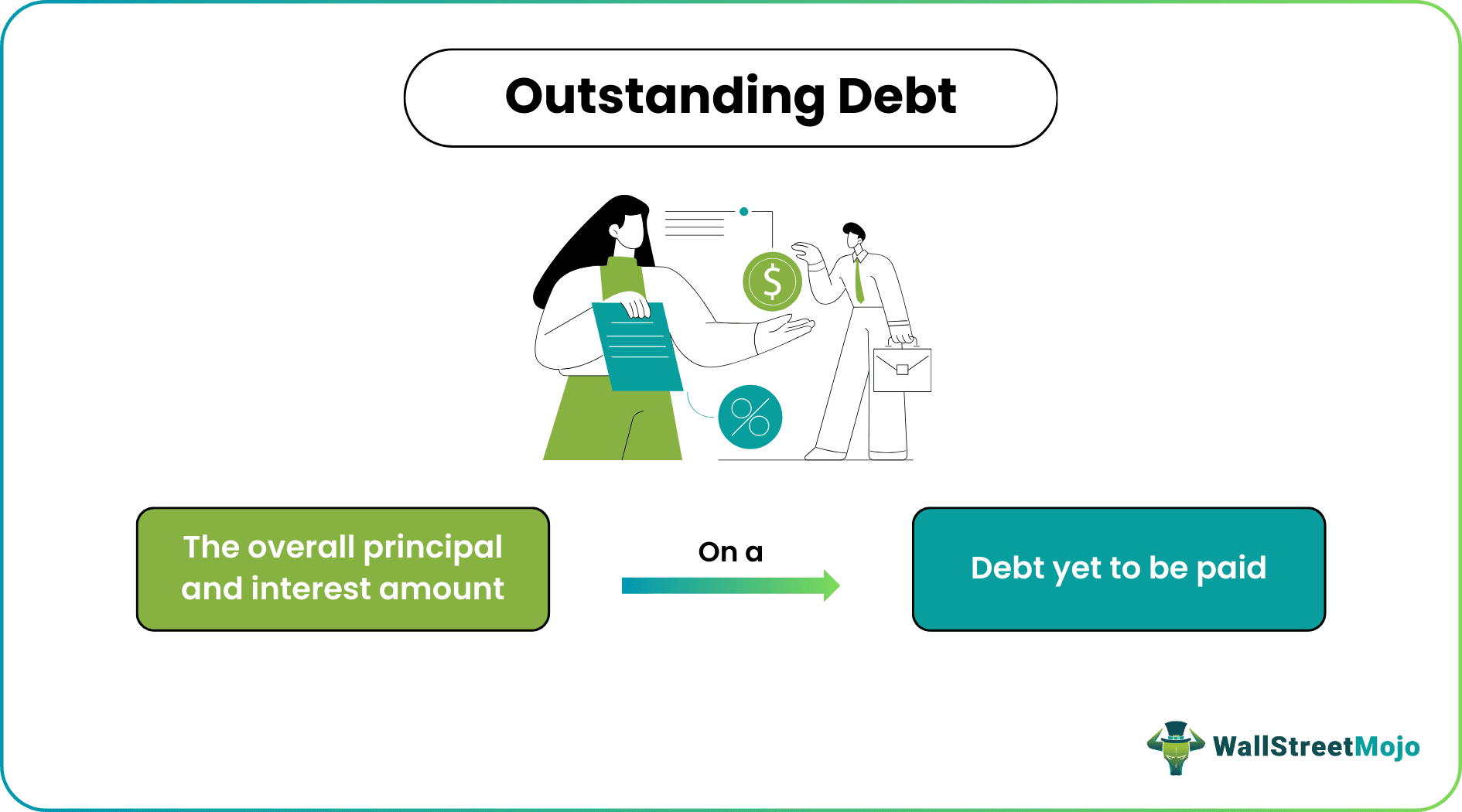Table Of Contents
Outstanding Debt Meaning
Outstanding debt is the overall amount businesses owe their lenders or creditors, including accrued interest. Investors and lenders check this crucial metric before investing and providing financial assistance. One can compute it by calculating the sum of current and long-term liabilities.

Excessive outstanding debt can negatively impact an organization’s credit rating. This, in turn, makes it difficult for businesses to avail of loans. In contrast, organizations that manage it efficiently can easily access necessary funds. As a result, they can expand their operations and take advantage of the opportunities.
Key Takeaways
- Outstanding debt definition is calculated by adding up an organization’s short-term and long-term debt. It includes the total principal and the interest yet to be paid by a company.
- Short-term debt includes taxes payable, accounts payable, wages payable, outstanding expenses, etc.
- If an organization fails to manage its outstanding debt balance efficiently, it might run out of operating capital necessary to carry on its business.
- Moreover, a very high amount of unpaid debt reduces a company’s credit rating.
- Businesses can calculate their outstanding debt by computing the sum of the overall principal owed and the total unpaid interest.
Outstanding Debt Explained
Outstanding debt definition refers to the amount owed to a single or multiple creditors. This amount includes the accrued interest. This metric is crucial for companies that utilize debt financing as it indicates whether an organization is over-leveraged or under-leveraged.
Typically, lenders do not provide financial assistance to businesses that do not manage their borrowings efficiently. In other words, companies with a low credit rating find it difficult to avail of financial assistance. Analysts can obtain essential debt-related data by plugging this metric into other formulas. That said, one must remember that this metric is not the only factor to consider when judging a business’s finances.
One must also factor in a company’s current ratio, debt-to-equity ratio, and other liquidity and leverage parameters. The current outstanding debt only tells individuals how much an organization owes its creditors.
The overall outstanding debt influences a business’s financial decisions. Small and medium-sized organizations specifically need to monitor this metric to avoid becoming over-leveraged. If a company takes on substantial debt, the interest payments might eat into its operating capital. Resultantly, the business may find it challenging to carry on operations.
When computing the overall amount of unpaid debt, a company considers its short-term and long-term debts. Let us look at some liabilities included in these two types of debts.
#1 - Short-Term Debt
Short-term debt includes the following:
- Accounts payable: This is the short-term debt that a company owes its creditors, suppliers, etc. Usually, companies pay off their accounts payable within the accounting period to avoid credit default.
- Wages payable: Companies owe wages to every employee in exchange for the services provided by them. The total wages earned by employees but not yet paid is the overall wages payable or accrued wages.
- Taxes payable: This refers to the income tax owed by an organization to the government.
- Short-term notes: A short-term note is a low-risk financing option that accrues monthly interest until the business pays the due amount within the agreement’s term. Like checks, short-term notes consist of terms negotiated between the borrower and the lender.
- Outstanding expenses: Also known as accrued expenses, outstanding expenses refer to the costs recorded before an organization incurred them. Moreover, companies consider deferred revenue when computing this metric.
#2 - Long-Term Debt
The following are a part of long-term debt:
- Capital Leases: Capital leases are temporary loans allowing renters to utilize the asset for the life of the lease in return for payment.
- Long-term Loans: These are loans with a repayment period ranging from 5-7 years. An example of a long-term loan is a business loan.
- Pension Liabilities: To calculate pension liabilities, one must find the difference between the amount yet to be paid to retirees and the amount available to the organization to make the payments. Employees receive this amount through a lump sum payment or via small installments.
- Deferred Compensation: These are payments made by organizations to their employees at a later date. Stock option plans and retirement plans are examples of deferred compensation. Employees may choose deferred compensation as their income is subject to taxation only after the company makes payment.
Besides these, current outstanding debt may include bonds payable.
Formula
The outstanding debt formula is as follows:
Outstanding Debt = Total Principal Amount Owed + Interests Yet To Be Paid Off
Calculation Example
Suppose XZY Company availed financial assistance from 4 creditors. The principal amounts are as follows:
- Creditor A: $50,000
- Creditor B: $10,000
- Creditor C: $30,000
- Creditor D: $40,000
In this case, the overall accrued interest is $14,000. Apart from this, there is no more liability.
Let us use the outstanding debt formula to compute the total amount XYZ Company has to pay its creditors.
Outstanding Debt = $50,000 + $10,000 + $30,000 + $40,000 + $14,000, i.e., $1,44,000.
Difference Between Outstanding Debt And Outstanding Capital
Outstanding debt and outstanding capital often confuse individuals new to the business. To avoid such confusion, they must understand the distinct characteristics of these two concepts. So, let us look at the critical differences between them.
| Basis Of Comparison | Outstanding Debt | Outstanding Capital |
|---|---|---|
| Meaning | The amount yet to be paid by businesses to their lenders. | It is the amount of capital yet to be paid by borrowers, provisions and interests excluded. |
| Formula | Total Principal Amount Owed + Interests Yet To Be Paid Off | Outstanding Capital = Initial Loan – Provision – Capital Received |

